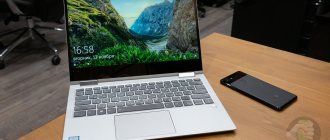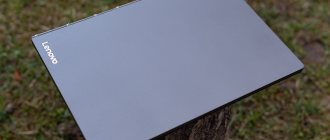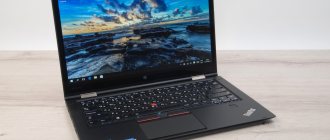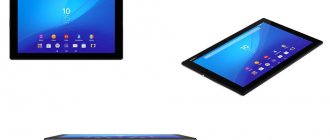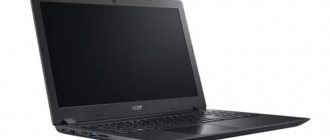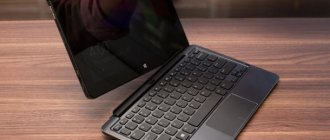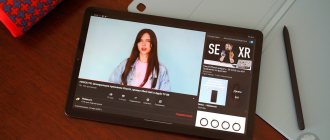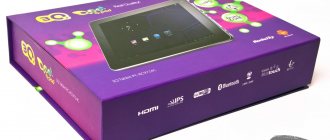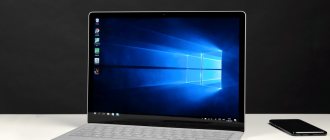Despite all its shortcomings (and there were quite a few), Yoga is a historically important tablet. It is notable for being the first mass-produced Android tablet to use cylindrical batteries rather than flat ones. The difference is simple: cylindrical ones provide greater capacity per gram of mass. However, they also require more free space for installation in the device case - our tablets and laptops are usually flat, and lately they have also been thin. Lenovo took the risk of going against the general trend - it turned out interesting and unusual.
Meet Lenovo Yoga Tablet 2 10”
The concept of Yoga tablets using the example of the first Lenovo Yoga Tablet 10”
Those same cylindrical batteries are installed in a rather grippy base of the tablet - that is why its thickness exceeds two centimeters. Lenovo marketers, however, are shy and in the official specifications they provide figures only for the “thin” part. They, it must be said, are much more interesting: the predecessor has from 6 to 8 mm, and the new version has from 3 to 7.2 mm.
Lenovo Yoga Tablet 2 10” - photo from the thin part
Does the cylindrical base interfere with the use of the device? Subjectively: not at all. The gadget easily fits into bags and backpacks, and holding it by the compartment with a stand is much more convenient than any flat tablet of the same weight. At least here there is something to grab onto.
Before starting testing, it should be noted that between the first generation of Yoga tablets and the second, the one discussed in this material, there was also an intermediate version. It was called Lenovo Yoga Tablet HD+. Unfortunately, we only talked with this version for a short time - in the conditions of Mobile Word Congress 2014 - and did not conduct detailed testing. Therefore, we will compare the new product mainly with the first generation Yoga Tablet.
⇡#Appearance and ergonomics
The device still weighs a lot: the same as its predecessors - just over six hundred grams. Frankly speaking, the mass is quite large: your hands can get tired from handling the device, for example, during a long trip on the subway. It should be taken into account that the center of gravity of the device is shifted towards the base, that is, the Lenovo Yoga Tablet is a rare full-size tablet that is more convenient to work with in portrait orientation rather than landscape.
Lenovo Yoga Tablet 2 10” - front panel
A pair of rather loud stereo speakers appeared on the front panel of the device. Their location is extremely good - while using the tablet, you won’t be able to close them with your hand, no matter which side you take it from. There are no hardware keys on the front panel. On the side of the display there is a 1.6-megapixel webcam peephole.
Lenovo Yoga Tablet 2 10” on a stand - side view
The built-in metal stand allowed Lenovo representatives to talk about three ways to use the device - as a console (the gadget stands on the surface), a keyboard (lying, leaning on the stand) and, in fact, as a tablet. In the new generation, the folding stand of the Yoga Tablet has a hole with which you can hang the gadget on a hook. Frankly speaking, we have not found any real application for such an opportunity. In theory, the tablet can be hung, for example, on the back of the seat in front of you on an airplane or used as an electronic photo frame.
Lenovo Yoga Tablet 2 10” - rear panel
Unfortunately, the main body material of the second generation Yoga Tablet is still plastic. True, they use synthetics here that are not so easy to distinguish from real aluminum (for example, we finally figured out the materials only when we put the device in the refrigerator). The back panel of the tablet is textured, so the device does not slip in your hands. The gadget looks really good - now there is at least a claim to the premium segment. All that remains is to replace the pseudo-metal in the exterior with real...
Lenovo Yoga Tablet 2 10” with open stand
Under the folding stand of the Yoga Tablet there are slots for a memory card and SIM card - if we are talking about a model with a built-in modem. In our test we had an option without it.
Lenovo Yoga Tablet 2 10” - side ends
The layout of the controls is quite convenient. The main keys and connectors are concentrated on the side ends. On one there are power buttons, volume controls and a Micro-USB interface, on the other there is a 3.5 mm audio jack for a wired headset. A white charging indicator appears around the power button. The location of the buttons is intuitive - we have absolutely no comments about the ergonomics of the device.
Unfortunately, there are questions about the assembly. The twisting and breaking test clearly showed that the design was noticeably lacking in stiffening ribs—when pressed from the sides, the display literally bent. True, there were no characteristic color stains - apparently, the matrix was well protected from physical damage. The plastic creaks, but we have long been accustomed to this. Yoga Tablet 2 looks noticeably more interesting and, so to speak, more expensive than the first generation gadget.
Appearance and location of keys
The model looks very expensive and impressive. This effect is largely achieved due to the fact that the manufacturer provided a harmonious combination of metal and plastic inserts. The folding stand, as well as the handle that hides the cylindrical battery, are made of aluminum, and all other components of the case are plastic.
The back cover has a matte structure that is non-slip and practically does not collect fingerprints. The main feature of all representatives of the Yoga Tablet model range is the use of a cylindrical battery. Despite its impressive size, the tablet is easy and comfortable to hold in your hand. It feels like a standard paper magazine. The design of the Lenovo Yoga tablet 2 pro 13.3 32gb deserves the highest praise, which is not at all surprising considering its cost.
Fortunately, the manufacturer did not abandon the stand, which allows you to fix the device at any angle. But now you can use it not only in console and keyboard modes, but also in picture mode. Such solutions have not previously been seen on the world market. It is worth noting that the stand is made of high quality, it can easily withstand the heavy weight of the gadget and certainly will not wobble from the slightest wind. In order to hang the tablet on the stand, you can use the provided hole. When the lid is closed, it frames the lens of the 8 MP camera, the opening key and the multimedia speaker.
As practice shows, this mode of use will be especially convenient when driving or on a picnic. It’s enough to hang the tablet on a tree branch and watch a movie with a friendly group, which is very convenient. In a separate niche located behind the stand there is a slot for a micro memory card. There is also an LTE modification on sale that allows you to place a SIM card.
The main feature of the tablet is the built-in projector located on the right side. There is a button nearby to activate it.
On the back cover there is a slider designed to focus the image generated by the projector.
On the left side there is a power key equipped with an indicator for missed notifications, a mini-jack for a headset, a volume rocker and a port for connecting a charger.
The display diagonal is 13.3 inches, this is a real giant among tablet computers. Above it is a 1.6 megapixel camera lens, and above and below there are two stereo speakers from JBL.
The disadvantages of the device include its high weight - 960 grams, which is a lot by modern standards. This can be explained by the use of a capacious 9600 mAh battery and a huge display. The tablet is best suited for home use, because carrying it will be quite heavy and not very comfortable. The assembly is made to a solid standard. There are no backlashes of moving components, gaps or cracks.
⇡#Technical characteristics
| Lenovo Yoga Tablet 10" | Lenovo Yoga Tablet 2 10” | |
| Display | 10.1 inches, 1280x800, IPS | 10.1 inches, 1920×1200, IPS |
| Touch screen | Capacitive, up to 10 simultaneous touches | |
| Air gap | No | |
| Oleophobic coating | No | Eat |
| Polarizing filter | Eat | |
| Platform | MediaTek MT8125/MT8389: Quad core ARM Cortex-A7 (ARMv7), 1.2 GHz; Process technology 28 nm | Intel Atom Z3745: Four Silvermont x64 cores; frequency 1.86 GHz; 22 nm process technology |
| Graphics controller | Imagination Technologies PowerVR SGX544, 533 MHz | Intel HD Graphics for BayTrail, 778 MHz |
| RAM | 1 GB LPDDR2 | 2 GB LPDDR3 |
| Flash memory | 16 GB (approx. 13 GB available) + MicroSD | |
| Connectors | 1 x Micro-USB 2.0 1 x 3.5mm headset jack 1 x MicroSD | |
| cellular | Optional (tested copies did not have a built-in modem) | |
| WiFi | 802.11b/g/n | 802.11a/b/g/n, 2.4/5 GHz |
| Bluetooth | 4.0 | |
| NFC | No | |
| IR port | No | |
| Navigation | GPS, A-GPS | GPS, A-GPS, GLONASS |
| Sensors | Accelerometer/gyroscope, digital compass, light sensor | |
| Main camera | 5 MP (2560×1920), autofocus, no flash | 8 MP (3264x2448), autofocus, no flash |
| Front-camera | 1.6 MP (1472×1104), no autofocus, no flash | |
| Nutrition | Non-removable battery, 33.3 WHr (9000 mAh, 3.7 V) cylindrical batteries | Non-removable battery, 36.5 WHr (9600 mAh, 3.8 V) cylindrical batteries |
| Dimensions | 261×180 mm Case thickness: 6-8 mm in the flat part, 21 mm in the cylindrical part | 255×183 mm Case thickness 3-7.2 mm in the flat part, 21 mm in the cylindrical part |
| Weight | 609 grams | 619 grams |
| Water and dust protection | No | |
| operating system | Google Android 4.2.2 (Jelly Bean) Custom shell | Google Android 4.4.2 (KitKat) Custom shell |
| recommended price | 13,990/14,990 rubles (Wi-Fi/3G) | 18,990 rubles |
Lenovo Yoga Tablet 2 10” - information about the system and hardware according to the CPU-Z application
Review and tests of Lenovo Yoga Tablet 2 10. Not like everyone else
Regularly testing tablets, when looking at the next one, melancholy rolls in, and the monotony is to blame for this. There are a large number of models on store shelves with similar filling and design; they are often distinguished only by the logo on the case. As a result, there are not many memorable models, but, nevertheless, they exist, one of them is the Lenovo Yoga Tablet line. Last year we tested the first generation, not so long ago the professional Lenovo Yoga Tablet Pro. For dessert we left the no less interesting Lenovo Yoga Tablet 2 10.
Several versions of the second generation entered the market at once. This, as before, is a version with an 8- and 10.1-inch display. In addition to Android, a Windows version has been added. As before, there are options with and without mobile Internet support, but now in addition to 3G there is also LTE. And, of course, there are two options depending on the amount of built-in memory. What unites them all is a single filling and a familiar body design. The main emphasis here is on improving the hardware, this concerns performance and the screen, but more on everything below.
Video review of Lenovo Yoga Tablet 2 10
Appearance
Lenovo Yoga Tablet 2 10 generally inherits the design from the first generation. It is well recognizable, and until now, models with cylindrical batteries based on Android and the same arrangement of the main filling have not appeared.
Speaking about the dimensions, and more precisely, about the thickness, here it varies from an average of 7 mm at the main part to 2 cm at the cylindrical thickening.
The approach to the design and shape of the case is non-standard. Moreover, here it is not just the task of designers to stand out from competitors at any cost; this form also turned out to be practical to use.
This thickening is somewhat reminiscent of the half of a magazine bent into a tube, and it is more convenient to hold this tablet in your hands in a portrait position. This position also provides a good grip.
Like the first version of the Yoga, the cylinder hides a folding leg. But with the Lenovo Yoga Tablet 2 10, the engineers went further, the rotation angle was increased by 90 degrees, and at the same time a hole was added in the center. This solution, as conceived by the engineers, will allow you to hang the tablet on the wall. You can mount it in the kitchen - to control recipes, hang it in the garage - to read manuals and instructions, mount it in front of you - getting something like a TV. You can come up with many directions. Surely the question arises: is it possible, simply armed with a drill and a drill, to do this trick on the first generation? Of course, you can drill a hole, even more than one, but the limitation in the angle of rotation of the leg will not allow you to hang it on the wall.
Under the cover there is a protective plug that hides the microSD and SIM connectors (in our version this compartment is solid).
The first generation had compartments at the corner of the leg niche. The design of the power button plays on the cylinder; it is round and has white backlighting along the edges. Just above there is a micro USB connector and a volume rocker.
An audio jack is located on the opposite side.
The correct location for the speakers has been chosen, they are paired here, they are directed at the user, the holes are located on the front part of the cylinder.
There is a question about the location of the front camera on the Lenovo Yoga Tablet 2 10. It is located in the center of the small edge. When placed on the desktop in the “frame” position, you have to change the angle of the screen towards the user, or move relative to the tablet. An upper bound would be logical. The current position will only be convenient for portrait orientation.
The main camera is located on the cylinder closer to the power button. Here you also have to grab the tablet by the display unit. The camera block itself does not protrude above the surface of the body; there is no LED flash.
The tablet body is made of plastic. Here it is qualitatively disguised as metal; it is difficult to answer unambiguously what material it is, especially when meeting for the first time. The tablet cover has a textured coating that ensures there are no problems with slipping out of your hands, and also hides fingerprints.
The Lenovo Yoga Tablet 2 10 is assembled perfectly, there are no complaints about the build quality.
Screen
A 10.1-inch display with a resolution of 1920×1200 pixels is installed. Density - 224 PPI. This is a high-quality IPS matrix with OGS technology (there is no air layer between the protective glass and the matrix). Maximum viewing angles, colors and brightness are not distorted. The illumination is uniform.
The brightness level can be assessed as average when compared with the models we tested earlier. There is automatic brightness adjustment. The color balance is slightly shifted towards warmer tones.
Filling
Lenovo Yoga Tablet 2 10 is built on the Intel Bay Trail-T platform, with an Atom Z3745 chip. This is a new Silvermont architecture that solves problems with processor downtime in complex tasks. Coming back to the processor, it is a 1.86 GHz quad-core chip with 2048 KB cache. Intel HD Graphics is responsible for graphics. There is 2 GB of LPDDR3 memory on board.
The level of performance here is sufficient for smooth operation of the interface and everyday tasks. No lags were noticed in complex games such as World of Tanks Blitz, GTA SA, Real Racing 3 and Asphalt 8.
Connection
Lenovo Yoga Tablet 2 10 has acquired optional support for LTE, networks of Russian operators in the list of supported ones. There is also support for Bluetooth 4.0, Wi-Fi (including 5 GHz), GPS and GLONASS. The communication modules operate stably, no failures have been recorded. Searching for satellites during a cold start takes about 30 seconds.
Antutu
Vellamo
3D Antutu
Battery
A battery with a capacity of 9600 mAh is responsible for autonomous operation. The battery here is cylindrical in shape, it consists of three parts of 3200 mAh. The volume is excellent, such capacity is rarely found in 8- and 10-inch tablets. A full charge lasts for 7 hours of watching high-definition videos. About 5.5 hours when gaming. For everyday use, you can charge the tablet every few days.
Camera
The main module of the Lenovo Yoga Tablet 2 10 has an 8 megapixel matrix. But everything is not as rosy as we would like; in terms of image quality, the camera is inferior to similar smartphone cameras. There are questions about focusing speed and the amount of noise in photographs. For good photos you need sufficient lighting and no shaking. The application supports several shooting modes and settings.
Software
The Google Android 4.4.2 operating system is installed with the prospect of an over-the-air update to 5.0. It uses Lenovo's own shell. Quite interesting to use. There are newfangled sliding smart panels and interface customization options. But with all this, the manufacturer makes it possible to roll back to a clean system without the need to obtain root access. We will look at the interface in more detail in a separate review. You can see more details about the tablet in the video review below.
Results for Lenovo Yoga Tablet 2 10
Lenovo Yoga Tablet 2 10 was a successful continuation of the series.
The tablet will be of interest to those who are still in the process of choosing a tablet or are looking for a replacement for their outdated model. Is it worth upgrading if you have the first Yoga? I think probably not, it is still relevant today, and at the same time cheaper. Otherwise, Yoga 2 gives the user a noticeably increased level of performance, Full HD resolution, LTE, and long battery life. I didn’t like the quality of the camera, it’s time for tablets to catch up to the level of smartphones. Otherwise, this is an excellent tablet that can be safely recommended when choosing an Android tablet. Lenovo Yoga Tablet 2 10 receives the well-deserved “Gold” award. MegaObzor.com Editor's Choice."
⇡#Display
The first generation of ten-inch Yoga Tablets featured very budget matrices with a resolution of 1280×800 pixels, which is painfully low for a full-size “tablet.” In addition, they were not configured well - the color gamut was significantly narrower than the sRGB reference space, and the gammas had a completely unnatural shape - as a result, the colors turned out faded and overexposed. And the viewing angles of the screen, despite the type of matrix (IPS), were not wide enough. In general, that display could not be called good.
Lenovo Yoga Tablet 2 received a more thoroughbred screen - with WUXGA resolution (1920x1200). A similar display was also installed in the HD+ version. Its pixel density is not the highest - 224 dots per inch: at the end of 2014 this is not surprising. The trend of the season is screens with Quad HD resolution, but “Yoga” did not get one. In fact, it is not really needed: at a distance of half-bent arms, individual pixels on the Yoga Tablet 2 10” screen are almost invisible. Now, if you bring the device closer to your eyes, it won’t be difficult to detect them, but you don’t stick your nose into the tablet. Movies and photos look good on the Yoga Tablet 2 10, but small fonts are somewhat lacking in sharpness.
The display, like the screen of its predecessor, is made using IPS technology - but this is, so to speak, a more correct IPS: the viewing angles of the second “Yoga” are much wider than those of the first. You can watch multimedia files together on the Yoga Tablet 2 10's screen—the colors won't fade if you look at it from an angle. The display is very responsive, it responds to touches even with gloves - you just need to activate the appropriate mode in the settings menu.
Lenovo Yoga Tablet 2 10” display supports up to ten simultaneous touches (according to AnTuTu MultiTouch Test)
The screen's brightness reserve is decent: the luminosity of the white field reaches 372 cd/m2. The indicator is not bad, but the brightness of competitors exceeds four hundred candelas per square meter. However, there is no need to complain about the lack of brightness. The Yoga Tablet 2 display has a polarizing filter that successfully combats glare. In addition, it does not have an air gap between the protective glass and the matrix itself, which reduces the number of unwanted reflections. In the dark, the device does not hurt the eyes: the minimum luminosity of the white field is only 17 cd/m2. The screen, as expected, has an oleophobic coating, thanks to which its surface is easy to clean from fingerprints and other dirt.
The luminosity of the black field at 100% backlight is 0.48 cd/m2. The resulting screen contrast is slightly less than desired - 775:1. The first “Yoga” was brighter, but things were worse with contrast. The new one has a normal indicator, but its competitors have more.
The color temperature of gray gradations is on average 7000 K. The result could be considered very good if not for its variability: halftones look more natural and more natural than dark and light gray gradations, which are slightly drawn to the “cold”. True, it will hardly be possible to see this in practice - the deviation is too insignificant.
Our tests clearly showed that the screen is not configured very carefully. The grayscale gamma curve has a noticeable bend in the middle part. This means that the undertones are darker than they should be. However, here the deviation is still forgivable.
But with gammas everything is even worse than in the first generation. Any shades of primary colors look much brighter than they should, especially blue. The color rendition is completely unnatural.
The color gamut of the screen is significantly narrower than the reference sRGB color space - only 71.8% of the latter. Saturation is lacking in red, blue, and green.
Lenovo Yoga Tablet 2 10” - tablet screen color gamut (yellow triangle) compared to sRGB color space (white triangle)
Display and sound
Since the Lenovo Yoga 2 Pro is a transformer, it is logical that the display is equipped with touch capabilities.
The display itself is protected by glossy glass - fingerprints remain on it, but not as much as happens. The same thing with glare and reflections - I can’t say that they were really annoying during work. Even MacBooks can envy the display resolution: an impressive 3200x1600 pixels (276 PPI), the color gamut is slightly larger than SRGB. Primary colors fit well into the standards (the research was carried out not by me, but by foreign journalists). The image is very, very high quality, it’s a pleasure to use Photoshop (although 13 inches is still not enough for this), surfing the web with perfectly clean and smooth fonts is a pleasure.
It doesn’t even smell like pixels.
The only disappointment is the brightness: the backlight is adjustable in very modest ranges, unlike the same MacBooks. If it is comfortable to use the screen indoors, then on the road or outdoors the maximum brightness reserves may not be enough.
The screen has rather thick frames (for 2014-2015), but this is quite logical - if you use the device as a tablet, then you need to somehow hold these almost one and a half kilograms. The appearance is slightly spoiled by the typical Asian huge silver brand logo and the touch-sensitive start key around the screen - in my opinion, they could have been made less noticeable.
A few words about the poses that Yoga 2 Pro can do. The manufacturer claims 4 options: tablet, laptop, tent and console. For each of them, the auxiliary utility offers to download the corresponding set of applications, but they are all rather boring and low-grade.
The most obvious option is when you work with a “laptop” as a “laptop”. You always forget about the touch screen, although the quality of the sensor and drivers allow you to abandon the touchpad altogether in 90% of cases. Despite the small interface elements (at such and such a resolution!), even with a rough, thick finger it is not difficult to get where you need to go.
If you rotate the laptop 360 degrees, it turns into a tablet. On a large tablet. The weight forces you to hold it on your knees rather than in your hands. The keyboard (on the back of the screen) is blocked in this position, but the feeling of discomfort from such metamorphoses will still not leave you. Spinning a one and a half kilo “steering wheel” in games is a great exercise for burning calories!
The third pose is the so-called console mode. This is when the device lies on the keyboard, and the screen itself is facing the user, but at the same time does not rest on anything - you cannot press on it too much. Pose for the sake of pose, I couldn’t do it 
The fourth option for using a tablet is to lay it out like a book and place it on the table - one of the most convenient positions for watching a movie. It takes up little space (less than a laptop), the speakers are aimed at the viewer, and the screen angle is quite comfortable.
Speaking of speakers. Yoga 2 Pro is equipped with stereo speakers - they are perfect for watching movies at home or listening to music in the background in a quiet office. But this is far from the capabilities of stereo systems in multimedia laptops.
⇡#Hardware and performance
The first generation featured a frankly budget MediaTek MT8125/MT8389 chip with four slow ARM Cortex-A7 cores operating at 1.2 GHz and single-core PowerVR SGX544 graphics. As a result, the tablet not only couldn’t cope with “heavy” toys, but it also slowed down even when surfing the web. The “intermediate” generation was equipped with an average-performing Qualcomm Snapdragon 400 system-on-chip, which we talked about more than once or twice; for example, in the Sony Xperia T3 review. It also used four Cortex-A7 cores, but the result was better.
In the Yoga Tablet 2 10”, Lenovo engineers installed the Intel platform from the Bay Trail-T family - Atom Z3745. It is made using a 22-nanometer technological process using Tri-Gate transistors, which should have a positive effect on the power consumption of the chip. The platform is built on the new Silvermont architecture, the peculiarity of which is the out-of-order execution of operations. This concept is known to avoid processor downtime when data for the next instruction is unavailable.
Lenovo Yoga Tablet 2 10” - AnTuTu MultiTouch Test 5.2 results
The Intel Atom Z3745 has four cores with a maximum frequency of 1.86 GHz. The volume of cache memory of the first level is 224 KB, the second one is 2048 KB. The graphics controller uses a proprietary solution from Intel HD Graphics, operating at a frequency of 778 MHz. The device has 2 GB of RAM. A “fast” LPDDR3 module is used. Flash memory capacity - 16 GB. If necessary, the memory can be expanded using microSD cards.
What can I say, when performing household tasks the device works very smoothly. Operating system animation, switching between applications, web surfing - all this happens on the Yoga Tablet 2 without any lag. The first “Yoga” could only dream of this. Very rarely does a gadget allow itself to “pull” the image, but this happens in exceptional cases. The device easily stores many open tabs and applications in memory. The gadget copes well with everyday tasks.
True, the load on the device must be dosed correctly: if you overdo it a little, it may start to slow down. For example, in the Basemark 2 Taiji gaming test, which is simple by modern standards, the gadget scored 46.5 FPS. The result is not bad, but most competitors hit the vSync limit of 60 frames per second. However, what is there is enough for simple 2D and 2.5D arcade games to run quite smoothly on the Yoga Tablet 2.
The tablet may have some difficulties with more resource-intensive applications. When launching, for example, Asphalt 8 at maximum graphic settings, the device slowed down somewhat; The FPS level often dropped below thirty frames per second, which is comfortable for the game. Obviously, the Yoga Tablet 2 10 is not suitable for avid gamers. True, if you reduce the graphics settings to medium or minimal, the toys practically do not slow down. The tablet easily plays video in different formats with resolutions up to Full HD - there are no problems with multimedia tasks.
Judging by the tests conducted, the new Intel Atom Z3745 platform cannot compete with the top solutions of the generally recognized industry leader - Qualcomm. For example, one of the best tablets of the past year, the Sony Xperia Z2 Tablet, which runs on the Snapdragon 801 chip, demonstrated the best results in gaming tests. In terms of power, the Atom Z3745 can be compared, roughly speaking and extremely approximately, with the Qualcomm Snapdragon 600 - a relatively powerful solution, but far from the most productive. At the same time, one cannot help but pay attention to how much the power of the Yoga Tablet 10 has increased compared to the first generation. The tablet is well suited for web surfing and multimedia; if you wish, you can even play on it, if you do not set the level of detail and texture development to the maximum.
Performance
Considering that the Lenovo IdeaPad Yoga 2 Pro (59-402619) is equipped with a touch display, it is no wonder that the manufacturer chose Windows 8.1 as the operating system, because it is best suited for touch control.
This configuration features a dual-core Intel Core i3-4010U processor with a clock frequency of 1.7 GHz and a 3 MB level 3 cache. There is no support for Turbo Boost technology, so this figure is the maximum possible. The CPU is built on the Haswell architecture, that is, the latest generation, it is made using a 22 nm process technology. The Core i3-4010U also supports Hyper-Threading, which allows up to four threads to be processed simultaneously by two cores. This processor is low-voltage, its TDP level is only 15 W. By the way, this chip is the least powerful among those offered in other configurations. In addition to it, the manufacturer installs Intel Core i5-4200U or Core i7-4500U in the Lenovo IdeaPad Yoga 2 Pro. Of course, the price for such models is significantly higher.
There is no discrete video card; after all, this ultrabook is not created for games, but, of course, there is a built-in one. The Intel HD Graphics 4400 is well suited for very low power consumption devices. It supports DirectX 11.1 and Shader 5.0, and is also capable of handling a variety of medium-complexity tasks, not to mention the simplest ones.
The RAM in the laptop is only 4 GB of DDR3L-1600 MHz standard. The RAM is soldered onto the motherboard, so increasing its capacity will not be possible. Information storage is provided by a 128 GB solid-state drive. This is the minimum, but you can choose a larger capacity – 256 GB and 512 GB.
⇡#Communication and interfaces
As we said earlier, in nature there are two versions of Lenovo Yoga Tablet 2 10 - with a built-in modem and without it. Unfortunately, we tested a tablet without a SIM card slot, so we can only tell you about the version with an optional modem what the manufacturer provides in its data. If you believe the official specifications, Yoga Tablet 2 with a cellular modem can work in fourth-generation networks at Russian frequencies. The theoretical maximum data download speed is 150 Mbps (LTE Cat. 4).
Otherwise, the set of wireless interfaces for different modifications of the tablet is the same: Bluetooth 4.0, dual-frequency Wi-Fi with support for all more or less common protocols, GPS and GLONASS. The Yoga Tablet 2 10 has neither NFC nor an infrared port, although in 2014 all this finally ceased to be a curiosity and migrated to the mass segment. The existing interfaces work without difficulty. The gadget connects to access points relatively quickly and transmits data via the “blue tooth” without unpleasant interruptions. What distinguishes the new product from the first “Yoga” is its support for Wi-Fi in the not yet heavily flooded 5 GHz range.
Lenovo Yoga Tablet 2 10” - AndroiTS GPS Test results outdoors
Within half a minute after the “cold” start, the device detected a total of 16 GPS and GLONASS satellites and navigated the terrain using eight of them. The error radius was moderate - about fifteen meters. It probably could have been even less if it had not been for cloudy weather during the test. You can connect peripheral devices to the gadget, such as external drives or a wired keyboard, using a USB On-the-Go (OTG) adapter.
Ports and communications
To place the interfaces in the Lenovo IdeaPad Yoga 2 Pro ultrabook, engineers used only the side edges, leaving the front and back empty.
On the right side of the gadget there is a USB port with a somewhat outdated version 2.0. It is equipped with a function for recharging external devices. Also here you can see a combined audio jack, an auto-lock screen rotation button, and a volume rocker. In addition, closer to the front edge there is a power button for the device with a corresponding indicator and a key to start the recovery system.
The left side is equipped with USB 3.0, a Micro-HDMI digital interface, and a 2-in-1 card reader.
By and large, this set is quite enough for normal work, but I would like to see an RJ-45 output and more USB 3.0 ports. Wireless technologies are very standard and familiar: Bluetooth 4.0 and Wi-Fi standard 802.11 b/g/n.
⇡#Autonomous work
The Lenovo Yoga Tablet 2 10 uses cylindrical batteries with a capacity of 3200 mAh each. There are three of them in total in the device. It is easy to calculate the total energy reserve - 36.5 Wh (9600 mAh, 3.8 V). For a ten-inch tablet, this is quite a lot - competitors are limited to about three quarters of this figure. Of course, Lenovo marketers push such a fat battery to the forefront when producing promotional products and boldly talk about eighteen hours of battery life, even talking about their testing methodology on a separate page on the official website. Probably, the device can really withstand 18 hours of operation without recharging, but under any significant load it discharges much faster.
For example, when continuously playing a video in HD 720p format with an active wireless connection and updating data in the background, the Lenovo Yoga Tablet 2 10 was discharged in seven hours - the result is far from a record. It is noteworthy that the device lasted only fifteen minutes longer when meeting this standard than the first generation Yoga Tablet. If you lower the brightness of the display, deactivate wireless networks and do not overload the processor cores, the tablet will probably be able to last the promised eighteen hours. However, in use scenarios close to real life, the gadget discharges faster - in ten to twelve hours, and if you use it for gaming purposes, it will discharge even faster.
True, the Yoga Tablet’s battery should appeal to those who are looking for a “sofa” tablet for infrequent use and solving non-resource-intensive tasks - that is, for reading email, e-books and communicating on social networks without getting out of bed. It so happened that we started testing the gadget a week and a half after we received it. At that moment he had about half the battery charge. After ten days, the tablet still had 11% of its battery remaining, which means that in standby mode the device consumes virtually no energy - this is a big plus. A full charging cycle takes about four hours.
⇡#Camera
The set of cameras on the Yoga Tablet 2 is quite standard for a full-size tablet: a front camera with a 1.6 megapixel sensor and a main one with an 8 megapixel sensor. There is no need to complain about the low resolution - it is quite enough for a device of this class. We suddenly have questions about the placement of cameras.
Lenovo Yoga Tablet 2 10” - example of a photograph taken with the front camera
If you place the tablet on the folding stand, the webcam will be to the left of the screen. Because of this, if you use a video call while sitting in front of Yoga, the image will be shifted to the right of center. It's a small thing, but it gets in the way. It’s strange, because in this position it’s much more convenient to communicate on Skype than holding a large full-size tablet in your hands in portrait orientation. It is still impossible to work with the rear camera with the stand folded down - it tries to get into the frame. To prevent this from happening, the tablet reminds you to close it before shooting. The problem is that there is no sensor in the stand - accordingly, the reminder always pops up, even if it is already closed. This does not interfere with the shooting process at all, but it can be somewhat annoying for particularly impressionable people.
Lenovo Yoga Tablet 2 10” - warning about the need to close the folding stand
With sufficient natural light, the pictures come out good - with natural color reproduction and decent detail; There are no artifacts in daytime images. Sharpness is decent across the entire field of the frame, without obvious drop-off towards the edges of the image. True, one cannot help but pay attention to the fact that, for example, the main camera of the iPad Air 2 has a significantly higher dynamic range in standard mode.
| Lenovo Yoga Tablet 2 10” | Apple iPad Air 2 |
As the lighting decreases, the sharpness of the images also decreases - the Yoga Tablet 2 camera has too aggressive software “noise reduction”, due to which the frame turned out to be too “soft” and unclear. The photo on Air 2 came out more detailed, but also much more “noisy” - it has more artifacts. The colors in both photographs are quite acceptable, as is the contrast. It's fine for tablet cameras.
| Lenovo Yoga Tablet 2 10” | Apple iPad Air 2 |
The Yoga Tablet 2 10 camera copes well with its main task - shooting text when there is nothing better suited at hand. The text is legible and readable across the entire frame, but it could look a little clearer. The tablet can record video in Full HD format (1920×1080 pixels).

